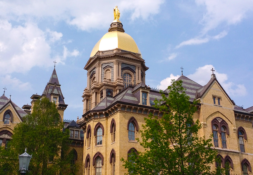The University of Notre Dame’s recently announced $400 million Campus Crossroads Project proposes splicing academic and student activities structures onto the football stadium, with mediating accommodations for potential benefactors. The Project would by design complete the process of establishing a second geographical focus for the university campus. Should the Project become actual, it would be a celebration in stone of the apparent drift of the university over the past three-quarters-century or more. This second geographical focus would be an outward sign of the inward disposition moving the university, willy-nilly, away from one central spiritual and intellectual center to an elliptical orbit about two foci.
That this generalization is more than a mere caricature is at least indirectly evidenced by statements announcing the purpose of the Project. To this evidence more direct and personal testimony might be added. Over the past 7 decades, 11 members of my family, spread across three generations, have attended Notre Dame. Some have even taught here. We have witnessed the drift.
There should be little question of which is tail and which dog in the proposed architectural hybrid. The whole Project might seem to be akin to affixing the Porch of the Stoics or the groves of the New Academy to the walls of the Colosseum. But a more extended and perhaps more appropriate analogy comes to mind.
In that peculiar, self-distanced American autobiography, The Education of Henry Adams, a memorable chapter titled “The Dynamo and the Virgin” celebrates the near-fatal irruption into Adams’ psyche of the phenomena of radioactivity and the generation of electrical energy. In the presence of the stories-high dynamos at the Paris International Exhibition of 1900 Adams claims that he found himself lying on the floor with “his historical neck broken by the sudden irruption of forces totally new.” These machines, Adams continues, were a “revelation of mysterious energy like that of the Cross; they were what, in terms of medieval science, were called immediate modes of the divine substance.”
The energy, the power, the sheer force that once emanated from the Virgin and enabled, for example, the construction of the Gothic cathedrals, Adams found transmogrified into or replaced by that force generated in the silently humming forty-foot high dynamos. Mysterious new forces, forces somehow akin to those once infused into man by the Cross and radiating through the Virgin Mary, had been unleashed upon the world, while the cathedrals became museums.
What some fear is that the completion of the Campus Crossroads Project would be, like the Paris Exhibition of 1900, a monumental display of the process of the transmutation or replacement of energy. In this case the segue would be from the Virgin to the dynamic of the commercial-athletic complex, a transmutation perhaps to be epitomized by the installation of a “JumboTron,” the “Feelies” of Brave New World on electronic steroids. Upon the Project’s completion, then, one could briefly traverse in space the traverse in time that Adams felt. One could move from the Grotto (Adams did admit that some Virginal force still seemed to emanate from Lourdes), or a chapel, or the Basilica, seeing and hearing what once dominantly moved the university, to a parking lot next the metastasized stadium and find oneself lying on one’s back, with one’s historical neck broken, feeling what moves it now.
A brief personal observation might be of use here. I believe that I have observed at Notre Dame the sort of evolution of energy that Adams noted in his autobiography. When I was a student at the university in the earliest 50s I had the sense that much of what many faculty members had to transmit to me they had learned on their knees. When I returned to teach late in the next decade I did not have the same sense about my colleagues.
Now the commercial-academic-scientific-technological complex does not recognize the knees as a primary organ of learning. And my sense of change upon returning to Notre Dame might be attributable in part to my having become slightly less naïve in the intervening years. But these years were years of significant change for the university. In this period, for instance, the administration apparently came to what it felt were necessary terms with leading foundations for the sake of increased access to academic affluence. And at the end of this transitional period came the noted Land of Lakes Conference. The Conference was concerned with intractable issues involving academic freedom, university governance and the relation of the Catholic university to the Church. Its “Statement,” though focused on the “nature and role of the contemporary Catholic University,” was not noted to have been issued “ex corde ecclesiae,” shall we say.
Perhaps an institutional drift toward elephantiasis, specialization of function, re-orientation and re-hierarchization of priorities is inevitable at a modern university, even a Catholic one. Perhaps the Land of Lakes “Statement” and the antecedent negotiations with foundations were most prudent. Perhaps the Campus Crossroads Project should be celebrated. Perhaps.
Perhaps we should also recall that, in many traditions, it was at the crossroads, a place “between the worlds,” that suicides were buried.
John Lyon earned his BA and MA from the University of Notre Dame (1954, 1955) in History and Literature and his PhD from the University of Pittsburgh in 1966 in the same subject. He has taught and held administrative posts at Notre Dame with the Program of Liberal Studies and the Graduate Program in the History and Philosophy of Science.


Leave a Reply